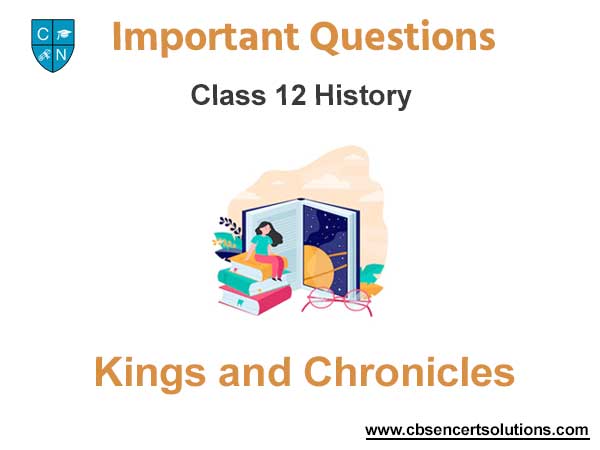Check the below NCERT MCQ Class 12 History Chapter 9 Kings and Chronicles with Answers available with PDF free download. MCQ Questions for Class 12 History with Answers were prepared based on the latest syllabus and examination pattern issued by CBSE, NCERT and KVS. Our teachers have provided below Kings and Chronicles Class 12 History MCQs Questions with answers which will help students to revise and get more marks in exams
Kings and Chronicles Class 12 History MCQ Questions with Answers
Refer below for MCQ Class 12 History Chapter 9 Kings and Chronicles. Solve questions and compare with the answers provided below
Question. Humayun expanded the frontiers of the empire, but lost it after being defeated in 1540, and was driven into exile. He took refuge after this loss. Where he took the refuge?
(A) Mings of China
(B) Uzbeks of Uzbekistan
(C) Chaghtai’s of Turkey
(D) Safavid’s of Iran
Answer
D
Question. Which of the following Mughal emperors wrote poetry and memoirs in Turkish language?
(A) Akbar
(B) Babur
(C) Humayun
(D) Aurangzeb
Answer
B
Question. Which among the following statement(s) is/are correct regarding the shifting of capitals between the 15th to 16th centuries?
(i) During the 1560s Akbar had the fort of Agra constructed with red sandstone quarried from the adjoining regions
(ii) In the 1570s, he decided to build a new capital, Fatehpur Sikri. One of the reasons prompting this may have been that Sikri was located on the direct road to Ajmer, where the dargah of Shaikh Muinuddin Chishti had become an important pilgrimage centre.
(iii) In 1585, the capital was transferred to Lahore to bring the North-West under greater control and Akbar closely watched the frontier for thirteen years.
(iv) In 1648 the court, army and household moved from Agra to the newly completed imperial capital, Shahjahana bad.
Which of the following statement(s) is/are correct?
(A) (i), (ii), (iii)
(B) (ii), (iii), (iv)
(C) (i), (iii), (iv)
(D) All of the above.
Answer
D
Question. ………….. was a form of ceremonial salutation in which the courtier placed the palm of his right hand against his forehead and bent his head suggesting that the subject has placed his head – the seat of the senses and the mind – into the hand of humility, presenting it to the royal assembly.
(A) Axis Mundi
(B) Kornish
(C) Paibos
(D) Sajda
Answer
B
ASSERTION AND REASON BASED MCQs :
Question. Assertion(A): The granting of titles to men of merit was an important aspect of Mughal polity.
Reason (R): A man’s ascent in the court hierarchy could be traced through the titles he held.
(A) Both A and R are true and R is the correct explanation of A.
(B) Both A and R are true but R is NOT the correct explanation of A.
(C) A is true but R is false.
(D) A is false and R is true.
Answer
A
Question. Assertion (A): Both for the Rajput clans as well as the Mughals marriage was a way of cementing political relationships and forging alliances.
Reason (R): This ensured a continuing hierarchical relationship between ruling groups.
(A) Both A and R are true and R is the correct explanation of A.
(B) Both A and R are true but R is NOT the correct explanation of A.
(C) A is true but R is false.
(D) A is false and R is true.
Answer
A
CASE-BASED MCQs :
Question. Study this Mughal painting entitled Jahangir’s dream carefully and answer the following questions by choosing the correct option:

Question. This Mughal painting is given the name of Jahangir’s dream because:
(A) It shows the two rulers Jahangir and Safavid Shah Abbas in a friendly embrace which was Jahangir’s desire.
(B) It gave a sense of authenticity to a scene which was fictional as the two rulers had never met.
(C) An inscription on this miniature records that Jahangir commissioned Abu’l Hasan to render in painting a dream the Emperor had recently seen.
(D) All of the above.
Answer
D
Question. The major attributes of the given painting were largely inspired by the:
(A) Incoming European art motifs and imaginaries in the Mughal court.
(B) Persian art motifs and imaginaries in the Mughal court.
(C) Turkish art motifs and imaginaries in the Mughal court.
(D) None of the above.
Answer
A
Question. The globe beneath the feet of both the Emperors suggests:
(A) The dream of Jahangir (the world seizure) to conquer the whole world by embracing his rival Shah Abbas.
(B) The globe is used by the painter to provide depth to the painting.
(C) The globe is representing the ideal world of humans and animals existing together.
(D) Both (B) and (C)
Answer
C
Question. A comparison of the physique and posture of both the Emperors in the painting portrays:
(A) The superiority of Jahangir over Shah Abbas as shown by the difference in the physical size of their respective portraits.
(B) The dream of Jahangir of embracing his rival Shah Abbas in a friendly manner to retain Qandhar.
(C) Both (A) and (B)
(D) None of the above.
Answer
C
